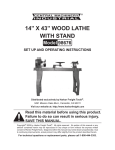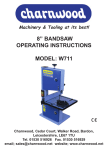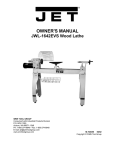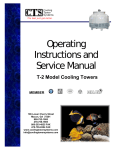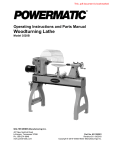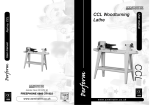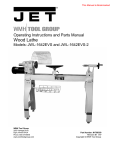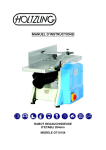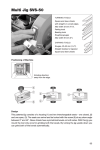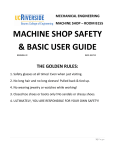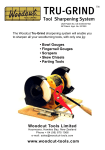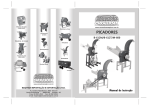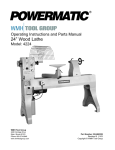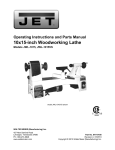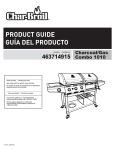Download heavy duty variable speed lathe operating instructions model
Transcript
HEAVY DUTY VARIABLE SPEED LATHE OPERATING INSTRUCTIONS MODEL: W850 Charnwood, Cedar Court, Walker Road, Bardon, Leicestershire, LE67 1TU Tel. 01530 516 926 Fax. 01530 516 929 email; [email protected] website; www.charnwood.net CONTENTS SPECIFICATIONS Input Power 230V, 50Hz Motor 1100W, 3Ph,230V,8136HZ, Max 4500rpm 2 Over Bed 400mm(16”) Special Safety Instructions 3 Swing Over Tool Rest Base 305mm(12”) Assembly 4 Distance Between Centers 1092mm( 42”) Unpacking 4 Contents 1 Specifications 1 General Safety Instructions Speeds (RPM) 0-1200 & 0-3200 Spindle Nose M33x3.5 Drive Spindle Through Hole 15mm (5/8”) Tailstock Spindle Through Hole 10mm (3/8”) Tailstock Spindle Travel 100mm(4”) Inventory 4 Clean-up 5 Assembly 5 Controls and Features 5 Tool Rest 355mm (14”) Speed Change 6 Face Plate 152mm(6”) Lathe Tools 7 Headstock Rotation O O O O 45 O, 90 ,135 ,180 ,270 Operation 7 Headstock Taper MT-2 Mounting Workpiece Between Centers 7 Tailstock Taper MT-2 Stock Selection 8 Roughing Out 8 Coves 8 “V” Cuts 8 Parting 9 Beads 9 Sanding & Finishing 9 Face Plate or Bowl Turning 9 Mounting Stock 9 Face Plate or Chuck 10 Wood Selection 10 Checks and Cracks 10 Distortion 10 Tools for Bowl Turning 10 To Shape Outside of Bowl 10 To Shape Interior of Bowl 11 Sanding and Finishing 11 Changing the Belt 11 Troubleshooting 13 Part Breakdowns and Part's List 14 Wiring Diagram 17 1 Spindle Center to Floor (approx) 1130mm(44-1/2”) Net Weight (approx) 175 kgs Shipping Weight (approx) 200 kgs GENERAL SAFETY INSTRUCTIONS advisable wherever possible to use an RCD (residual current device) at the mains socket. Please read the following instructions carefully, failure to do so could lead to serious personal injury. STAY ALERT: Always watch what you are doing and use common sense. Do not operate the saw when you are tired or under the influence of alcohol or drugs. When using electric tools, basic safety precautions should always be followed to reduce the risk of fire, electric shock and personal injury. DISCONNECT THE TOOL FROM THE MAINS SUPPLY: When not in use, before servicing and when changing accessories such as cutters, etc. Read all these instructions before operating the tool and save this user manual for future reference. AVOID UNINTENTIONAL STARTING: Make sure the switch is in the OFF position before connecting the tool to the mains supply. We recommends that this tool should not be modified or used for any application other than that for which it was designed. If you are unsure of its relative applications do not hesitate to contact us using the telephone number on the back of this user manual, and we will be more than happy to advise you. NEVER LEAVE THE TOOL RUNNING / CONNECTED WHILST UNATTENDED: Turn off the tool and disconnect it from the mains supply between jobs. Do not leave machine until it comes to a complete stop. DO NOT ABUSE THE MAINS LEAD: Never attempt to move the saw by means of the mains lead or pull it to remove the plug from the mains socket. Keep the mains lead away from heat, oil and sharp edges. If the mains lead is damaged, it must be replaced by the manufacturer or its service agent or a similarly qualified person in order to avoid unwanted hazards. KNOW YOUR POWER TOOL: Read and understand the owner's manual and labels affixed to the saw. Learn its applications and limitations, as well as the potential hazards specific to this tool. KEEP WORK AREA CLEAN AND WELL LIT: Cluttered work benches and dark areas invite accidents. Floors must not be slippery due to oil, water or sawdust etc. CHECK FOR DAMAGED PARTS: Before every use of the tool, a guard or other part that is damaged should be carefully checked to determine that it will operate correctly and perform its intended function. Check for alignment of moving parts, free running of moving parts, breakage of parts, and any other conditions that may affect its operation. A guard or other part that is damaged should be correctly repaired or replaced by an authorized service centre unless otherwise indicated in this instruction manual. Have defective switches replaced by an authorized service agent. Do not use the tool if the switch does not turn it on and off. DO NOT USE THE SAW IN DANGEROUS ENVIRONMENTS: Do not use power tools in damp or wet locations, or expose them to rain. Provide adequate space surrounding the work area. Do not use in environments with a potentially explosive atmosphere. KEEP CHILDREN AND UNTRAINED PERSONNEL AWAY FROM THE WORK AREA: All visitors should be kept at a safe distance from the work area. KEEP ALL GUARDS IN PLACE: And in full working order. STORE TOOLS SAFELY WHEN THEY ARE NOT IN USE: All tools should be stored in a dry, locked cupboard and out of the reach of children. MAINTAIN TOOLS WITH CARE: Keep tools sharp and clean for the best and safest performance. Follow instructions for lubricating and changing accessories. All extension cables must be checked at regular intervals and replaced if damaged. WEAR THE CORRECT CLOTHING: Do not wear loose clothing, neckties, rings, bracelets, or other jewellery, which may get caught in moving parts. Non-slip footwear is recommended. Wear protective hair covering to contain long hair. Roll long sleeves up above the elbow. USE ONLY RECOMMENDED ACCESSORIES: Consult this user manual for recommended accessories. Follow the instructions that accompany the accessories. The use of improper accessories may cause hazards and will invalidate any warranty you may have. USE SAFETY GOGGLES AND EAR PROTECTION: Wear CE approved safety goggles at all times, Normal spectacles only have impact resistant lenses, they are NOT safety glasses. A face or dust mask should be worn if the operation is dusty and ear protectors (plugs or muffs) should be worn, particularly during extended periods of operation. PROTECT YOURSELF FROM ELECTRIC SHOCK: When working with power tools, avoid contact with any earthed items (e.g. pipes, radiators, hobs and refrigerators, etc.). It is REMOVE ADJUSTING KEYS AND WRENCHES: Form a habit of checking to see that keys and adjusting wrenches are removed from the tool before every use. 2 DO NOT ABUSE THE MAINS LEAD: Never attempt to move the saw by means of the mains lead or pull it to remove the plug from the mains socket. Keep the mains lead away from heat, oil and sharp edges. If the mains lead is damaged, it must be replaced by the manufacturer or its service agent or a similarly qualified person in order to avoid unwanted hazards. be carried out by qualified persons using original spare parts, otherwise this may result in considerable danger to the user. SPECIAL SAFETY INSTRUCTIONS CHECK FOR DAMAGED PARTS: Before every use of the tool, a guard or other part that is damaged should be carefully checked to determine that it will operate correctly and perform its intended function. Check for alignment of moving parts, free running of moving parts, breakage of parts, and any other conditions that may affect its operation. A guard or other part that is damaged should be correctly repaired or replaced by an authorized service center unless otherwise indicated in this instruction manual. Have defective switches replaced by an authorized service agent. Do not use the tool if the switch does not turn it on and off. 1. KEEPING GUARDS IN PLACE. Make sure all guards are in place and that the lathe sits on a flat, stable surface. 2. EYE/FACE PROTECTION. Always wear eye protection or a face shield when operating the lathe. 3. RESPIRATORY PROTECTION. Always wear a respirator when using this machine. Wood dust may cause allergies or longterm respiratory health problems. 4. MOUNTING WORKPIECE. Before starting, be certain the workpiece has been properly imbedded on the headstock and tailstock centers and that there is adequate clearance for the full rotation. KEEP ALL GUARDS IN PLACE: And in full working order. MAINTAIN TOOLS WITH CARE: Keep tools sharp and clean for the best and safest performance. Follow instructions for lubricating and changing accessories. All extension cables must be checked at regular intervals and replaced if damaged. 5. ADJUSTING TOOL REST. Adjust tool rest to provide proper support for the turning tool you will be using. Test tool rest clearance by rotating workpiece by hand before turning lathe ON. USE ONLY RECOMMENDED ACCESSORIES: Consult this user manual for recommended accessories. Follow the instructions that accompany the accessories. The use of improper accessories may cause hazards and will invalidate any warranty you may have. 6. TURNING SPEED. Select the correct turning speed for your work, and allow the lathe to gain full speed before using. 7. USING SHARP CHISELS. Keep lathe chisels properly sharpened and held firmly in position when turning. REMOVE ADJUSTING KEYS AND WRENCHES: Form a habit of checking to see that keys and adjusting wrenches are removed from the tool before every use. 8. OPERATING DAMAGED LATHE. Never operate the lathe with damaged or worn parts. 9. WORKPIECE CONDITION. Always inspect the condition of your workpiece. DO NOT turn pieces with knots, splits, and other potentially dangerous conditions. Make sure joints of glued-up pieces have high quality bonds and won't fly apart during operation. DO NOT OVERREACH: Keep proper footing and balance at all times. USE THE RIGHT TOOL: Do not use the tool or attachment to do a job for which it was not designed. 10. ADJUSTMENTS/MAINTENANCE. Make sure your wood lathe is turned OFF, disconnected from its power source, and all moving parts have come to a complete stop before starting any inspection, adjustment, or maintenance procedure. DO NOT FORCE THE TOOL: It will do the job better and more safely at the rate which it was designed. DO NOT OPERATE POWER TOOLS IN EXPLOSIVE ATMOSPHERES: Do not use the tool in the presence of flammable liquids, gases, dust or other combustible sources. Power tools may create sparks which can ignite the dust or fumes. 11. STOPPING LATHE. DO NOT stop the lathe by using your hand against the workpiece. Allow the lathe to stop on its own. DO NOT EXPOSE THE TOOL TO RAIN OR USE IT IN WET CONDITIONS: Water entering a power tool will greatly increase the risk of electric shock. 12. AVOIDING ENTANGLEMENT. Keep long hair and loose clothing articles such as sleeves, belts, and jewelry items away from the lathe spindle. HAVE YOUR TOOL REPAIRED BY A QUALIFIED PERSON: The tool is in accordance with the relevant safety requirements. Repairs should only 3 3. FACEPLATE TURNING. When faceplate turning, use lathe chisels on the downward spinning side of the workpiece only. ASSEMBLY Unpacking 14. SANDING/POLISHING. Remove the tool rest when performing sanding or polishing operations on the rotating spindle. The wood lathe was carefully packed when it left warehouse. If you discover the machine is damaged after you have signed for delivery, please immediately call Customer Service for advice. 15. MATERIAL REMOVAL RATE. Attempting to remove too much material at once may cause workpiece to fly out of the lathe. Save the containers and all packing materials for possible inspection by the carrier or its agent. Otherwise, filing a freight claim can be difficult. When you are completely satisfied with the condition of your shipment, you should inventory the contents. Inventory After all the parts have been removed from the crate, you should have the following items: Inventory Components A. Lathe Bed B. Stand Legs C. Headstock D. Tailstock E. Tool Rest Body F. Tool Basket G. Guard Assembly H. Owner’s Manual I. Accessory Package Accessory Package Box 1. Live Center 1. Rod for Live Center 1. Spur Center 1. Index Pin 1. Face Plate 1. Knockout Rod Headstock 1. Tool Rest 1. Tool Rest Extension 4. Adjustable Feet 4 Qty 1 2 1 1 1 1 1 1 1 Clean-Up 7. Adjust the feet so that the lathe rests evenly on the floor, and tighten the nuts. 1. Remove the shipping container. Do not discard any shipping material until the lathe is set up and running properly. Controls & Features 2. Remove hex cap bolts from skid bottom and move the lathe off the skid and into position. 1. Headstock Lock Handle: (C,Fig.4) Locks head in position. Unlock handle to position the head along lathe bed. Tighten handle when properly positioned. 3. Clean all rust protected surfaces with a cleaner degreaser. Clean thoroughly under the headstock, tailstock and tool rest body. 2. Headstock Indexing Pin:(D,Fig.4) Turn the knurled knob counter-clockwise to unlock the plunger. Pull the knob out to release the headstock. Unlock the headstock locking handle and rotate the headstock. Turn knurled knob clockwise until it stops to lock plunger. Assembly 1. Secure tool rest (A, Fig. 2) to tool rest body (B, Fig.2) by tightening handle (C,Fig.2). 3. Headstock Spindle Lock: (E,Fig.4) Push pin in to keep the spindle from turning. 2. Slide the tailstock and tool rest to the headstock end of the lathe bed. See “Controls and Features” section of this manual on how to move the tailstock and tool rest. CAUTION! Never press the headstock spindle lock while the spindle is turning! 4. Headstock On/Off Button: (F,Fig.4) Pull the button out to turn “ON” the lathe. Push the button in to turn the lathe “OFF”. 5.Headstock RPM Knob: (G,Fig.4) Turn knob to desired RPM. There are two speed ranges offering “speed”(0-3200) and “torque”(01200). 6. Headstock For/Rev Switch: (H,Fig.4) Use the toggle switch to change the direction the spindle turns. Only change direction when the spindle has stopped. 3.Lift the tailstock end of the lathe up far enough to slide a few pieces of scrap wood under the leg, see Figure 2. 4. Thread adjustable feet (A, Fig. 3) into stand leg (B, Fig. 3). There is a flat spot on the shaft near the foot that will accommodate a wrench. Thread a hex nut (C, Fig. 3) onto shaft and leave loose for now. B C A 7. Headstock RPM Readout: (I,Fig.4) Displays the spindles RPM, see Figure 4. 5. Remove the scrap pieces of wood and slide the tailstock, tool rest and headstock down to the tailstock end of the late bed. 8. Headstock Spur Center: (J,Fig.4) Used for turning between centers. Spindle taper is MT-2. Remove spur center by inserting drift rod through the opposite end of the spindle and knocking spur center out. 6. Mount the two adjustable feet in the same manner as above and move the headstock, tool rest and tailstock into their normal positions. 5 11. Tool Rest Body Lock Handle: (M,Fig.7) Locks the tool rest body in position. Unlock handle to position the tool rest in any location along lathe bed. Tighten handle when properly positioned. 12. Tool Rest Lock Handle: (N,Fig.7) Locks the tool rest in position. Unlock the handle to position tool rest at a specific angle, or height. Tighten handle when properly positioned. P R Q O L K 13. Tailstock Lock Handle: (O,Fig.8) Locks the tailstock in position. Unlock handle to position the tool rest in any location along lathe bed. Tighten handle when properly positioned. 14. Tailstock Quill Lock Handle: (P,Fig.8) Locks the tailstock quill in position. Unlock handle to position the quill. Tighten handle when properly positioned. 9. Headstock Faceplate: (K,Fig.6) Used for turning bowls and plates. There are a number of screw holes for mounting the work piece. Thread the faceplate onto the spindle in a clockwise direction, and tighten two set screws. Remove the faceplate by loosening two set screws. Push in headstock spindle lock and use the provided rod in faceplate holes to unthread the faceplate. 15. Tailstock Quill Handwheel: (Q,Fig.8) Turn the handwheel to position the quill. The tailstock quill lock handle must be loose to position quill. 16. Tailstock Live Center: (R,Fig.8) Used for turning between centers. Quill taper is MT-2. Remove live center by retracting the quill until live center loosens. Remove, or add different tips to the live center by inserting the provided rod through the holes in the center's shaft. Unscrew the tip and change as needed. 10. Headstock Indexing Hole: (L,Fig.6) Thread indexing pin into the indexing hole making sure that it locates in the spindle hole. There are 12 holes in the spindle 3 0° apart. There are three holes in the headstock casting that accept the indexing pin. These holes are 20° apart. The combination of holes will allow you to mark your workpiece for evenly spaced features. Speed Change 1. Disconnect the machine from the power source! CAUTION! Never start the lathe with the index pin engaged in the spindle! 2. Loosen the locking Screw (A, Fig. 9). 3. Lift up on the tensioning handle (B, Fig. 9) to remove tension from the poly v-belt. You can now position the belt in the desired speed range. It is pictured in the low speed pulley range. Note: The “High” speed range (0-3200) provides maximum speed, where as the “Low” speed range (0-1200) will provide maximum torque. 4. Lower the tensioning handle so that the weight of the motor provides the needed tension and tighten the locking handle. N AC Inverter does not require any programming. It is pre-programmed from the factory. The buttons and knob on the face of inverter should not be changed. Use only controls on the front of headstock. Refer to Inverter manual. M 6 OPERATION Mounting Work piece Between Centers Spindle turning takes place between the centers of the lathe. It requires a spur center in the headstock and a live center in the tailstock. 1. With a ruler locate and mark the center on each end by going corner to corner, see Figure 11. Accuracy is not critical on full rounds but extremely important on stock where square sections are to remain. Put a dimple in each end of the stock with an awl, or nail. B A Lathe Tools If possible, select only high quality, high speed steel turning tools with long handles. As one becomes proficient in turning, a variety of specialty tools for specific applications can be acquired. The following tools provide the basics for most woodturning projects. Roughing Gouge -used for rapidly cut raw wood into round stock, see Figure 10. Deep Fluted Bowl Gouge -used for turning bowls and plates, see Figure 10. Spindle Gouge -used for turning beads, coves and other details, see Figure 10. 2. Extremely hard woods may require kerfs cut into the spur drive end of stock, see Figure 11. You may need to drive the spur center into the stock with a wood mallet. Note: Never drive stock onto spur while it is mounted in the lathe spindle. Spear -fine scraping and delicate operations, such as the forming of beads, parallel grooves and shallow vees, etc, see Figure 10. Skew -used to make vees, beads, etc. , see Figure 10. Square Scraper -used for diameter scraping and featureless scraping, etc, see Figure 10. 3. Install workpiece by inserting the attached spur center into the spindle taper on the headstock. Large Domed Scraper -used to reduce ridges on the interior of bowls, round edges of bowls, etc, see Figure 10. 4. Bring tailstock into position, lock it to the bed, and advance quill with the handwheel in order to seat the live center into the workpiece. Lock the quill in place. Make sure the live center point is centered on your mark. Parting Tool -used to cut directly into the material, or to make a cut off. Also used for scraping and to set diameters, see Figure 10. 5. Move tool rest into position. It should be parallel to workpiece, approximately at the centerline, and approximately 1/8" from the closest part of the workpiece. Lock tool rest body and tool rest in place. For safety and best performance, keep tools sharp. If a tool stops cutting, or requires excessive pressure to make a cut, it needs to be sharpened. A number of brand name sharpening jigs and fixtures are available, however, a woodturner should learn to sharpen tools freehand. 6.Rotate workpiece by hand to check for proper clearance from tool rest. Note: You may want to trim off the corners of a square workpiece to make turning a little easier, see Figure 12. 7.Start lathe at lowest speed and bring it up to the appropriate RPM for the size of stock, see Figure 5 page 8. The position of the tool rest can be varied to suit the work and operator. After you become experienced with setting the tool rest changing the position will become second nature for the workpiece and comfort of the user. 7 points of the skew to the spinning workpiece may cause a catch and ruin the workpiece. Stock Selection Stock for spindles should be straight grained and free of checks, cracks, knots and other defects. It should be cut 1/8" to 1/4" larger than the finished diameter and may require additional length to remove ends if required. Larger stock should have the corners removed to produce an octagon making the piece easier to rough down to a cylinder, see Figure 15. 5. Add details to the workpiece with skew, spindle gouge, etc. Roughing Out 1. Use a large roughing gouge and begin cutting about 2” from the tailstock end of the workpiece. Place the tool on tool rest with heel of the tool on surface to be cut. Coves 1. Use a spindle gouge. With the flute of the tool at 90 degrees to workpiece, touch the center of the cutting edge to the workpiece and roll in towards the bottom of the cove. Stop at the bottom; attempting to go up the opposite side may cause the tool to catch. 2. Slowly and gently raise tool handle until cutting edge comes into contact with the workpiece. Work to the right towards the end of the workpiece. You never want to start at the end of a workpiece. 3. Now continue to work the rest of the workpiece. Roll the flute (hollowed-out portion) of the tool in the direction of the cut, see Figure 13. Make long sweeping cuts in a continuous motion to rough the piece down to a cylinder. Keep as much of the bevel of tool as possible in contact with workpiece to ensure control and avoid catches. Note: Always cut down-hill, or from large diameter to small diameter. Always work toward the end of a workpiece, never start cutting at the end. 2. Move tool over the desired width of cove. 3. With the flute facing the opposite direction, repeat step 1 for other side of cove. Stop at bottom of cut, see Figure 16. “V” Cuts 1. Use the long point of the skew. Note: Do not press the long point of the skew directly into the workpiece to create the "V"; this will result in a burned, or burnished "V" with fibers being rolled up at both sides. 4. Once the workpiece is roughed down to a cylinder, smooth it with a large skew. Place the cutting point near the center of the chisel and high on the workpiece, see Figure 14. Touching one of the 8 2. Lightly mark the center of the "V" with the tip of the skew. 3. Move the point of skew to the right half of the desired width of your cut, see Figure 17. Face Plate & Bowl Turning Face plate turning is normally done on the inboard side of the headstock over the bed, see Figure 18. You must move headstock to the end of the lathe bed for larger workpieces. 4.With the bevel parallel to the right side of the cut, raise the handle and push the tool in to the desired depth. 5. Repeat from the left side. The two cuts should meet at the bottom and leave a clean " V" cut. WORK PIECE 6. Additional cuts may be taken to add to either the depth or width of the cut. Mounting Stock Use of a face plate is the most common method for holding a block of wood for turning bowls, and plates, see Figure 19 . Parting WORK PIECE 1. Place parting tool on tool rest and raise the handle until it starts to cut and continue to cut to the desired depth. FACE PLATE #12 C’SUNK SCREWS 2. If the cut is deep a clearance cut should be made along side the first cut to prevent the tool tip from burning. Beads WASTE BLOCK 1. Place parting tool on tool rest and move tool forward to make the full bevel of tool come in contact with workpiece. Gently raise handle to make cut to appropriate depth. 2. Repeat for other side of the bead. 1. Select stock at least 1/8" to 1/4" larger than the dimension on the desired finished workpiece. 3. Using a small skew or spindle gouge, start in the center between the two cuts and cut down each side to form the bead. Roll the tool in direction of cut. 2. True one surface of workpiece for mounting against the face plate. It is best to leave extra stock against the face plate that can be cut off when the workpiece is finished. Sanding & Finishing 3. Using the face plate as a template, mark the location of the mounting holes, and drill pilot holes of the appropriate size. If the mounting screws on the face plate interfere with the workpiece, a waste block can be mounted to the face plate and then the waste block mounted to the workpiece by gluing or screwing, see Figure 19 . Leaving clean cuts will reduce the amount of sanding required. Adjust lathe to a finishing speed, and begin with fine sandpaper (120 grit or finer). Coarser sandpaper will leave deep scratches that are difficult to remove, and dull crisp details. Fold the sandpaper into a pad; do not wrap sandpaper around your fingers or the workpiece. 4. Both waste block and workpiece should have good flat surfaces. To apply a finish, the workpiece can be left on the lathe. Turn off lathe and use a brush, or cloth to apply the finish. Remove excess finish before restarting lathe. Allow to dry and sand again with 320, or 400 grit sandpaper. Apply additional coats of finish and buff. 5. Push in the spindle lock and thread face plate and workpiece onto spindle. Tighten set screws in face plate when secure. 9 by a bowl gouge. Face Plate or Chuck While faceplates are the simplest, most reliable method of holding a block of wood for turning, chucks can also be used. A chuck is not a requirement but is handy when working on more than one piece at a time. Rather than removing screws, you simply open the chuck and change workpieces. The most popular ones are four jaw scroll chucks with a variety of jaws to accomodate different size tenons. Most also come with a screw chuck as well. To Shape Outside of Bowl 1. Odd shaped burls, crotches and other irregular shaped blanks require special preparation before mounting in a chuck, or onto a faceplate. Remove the bark, if there is any, from what appears to be the center of the top of workpiece. 2. Drive spur center into the top of workpiece with a wood mallet. Wood Selection 3. Slip spur center into headstock taper and bring the tailstock, with a live center into position. Lock tailstock to bed and advance spindle in order to seat the cup center into workpiece, see Figure 19. Tighten quill lock. Firewood is the cheapest, most widely available stock to use while learning to turn bowls. Develop skill with each tool before attempting to make a finished piece. It is best to start with dry wood, without worrying about drying or distortion. Once turning becomes comfortable, try green wood which cuts very easily. As the turner gains experience, he or she will find extraordinary grain and figure in the form of burls, crotches and bark inclusions. 4. Position tool support just below the centerline and about 1/4" from the workpiece. Note: For larger outboard turning, an optional outboard turning stand is used to place the tool support. 5. Turn workpiece by hand to ensure proper clearance. Checks & Cracks 6. Start lathe at lowest speed and bring it up to the maximum safe speed for the size of work to be turned, see Figure 7 on page 10. If the machine starts to vibrate, lower the speed until vibration stops. Green wood will check and crack. For best results, leave logs in as long lengths as you can handle. As the material starts to dry, surface cracks will develop on the ends of the log. Cut off two to three inches and you should find good, sound wood. Also cut the log in half along the pith to avoid having it in the finished piece. Most checks radiate from the pith. As you turn bowls from green wood, make sure you maintain a consistent wall thickness throughout the piece. Leaving a piece thick in some areas and thin in others will cause the wood to dry unevenly and promote checks and cracks. 7. Rough out the outside of the bowl with the 1/2" deep fluted bowl gouge, holding the tool firmly against your hip. For best control, use your whole body to move the gouge through the workpiece. 8. As the bowl takes shape, work on the bottom (tailstock end) to accommodate attaching a face plate, see Figure 20. Distortion Distortion is a problem associated with turning green wood. It will vary from one type of wood to the next. Typically, fruitwoods tend to distort more than others. It also varies with the time of year the tree was cut and how the logs are stored. Tools for Bowl Turning The deep fluted bowl gouge is the most essential and versatile tool for most bowl and faceplate style turning. The bowl gouge is heavier and easier to control than other types of gouges. It also allows removal of wood much faster and with less vibration than other gouges. Most average sized bowl work can be accomplished with a 3/8" or 1/2" bowl gouge. A 1/4" bowl gouge is best suited for smaller bowls and light finishing cuts. 9. Turn a short tenon (about 1/8" long) the size of the hole in the faceplate, see Figure 19. This will allow centering the workpiece when the faceplate is attached. Note: If you plan to use a chuck, turn a tenon of appropriate length and diameter to fit your chuck. 10.Stop the lathe, remove workpiece and attach face plate, or chuck. Larger 3/4" and 1" bowl gouges are only used for extremely large pieces. Large domed scrapers can also be used to help clean up the interior surfaces of bowls. A light touch with the scraper slightly tilted will eliminate some of the ridges left 10 11.Finish turning the outside of bowl with 1/2" or 3/8" bowl gouge. Leave additional material at base of bowl for support while turning interior. This will be removed later. To Shape Interior of Bowl 2. Begin with fine sandpaper 120 grit and progress through each grit, using only light pressure. Coarser sandpaper tends to leave deep scratches that are hard to eliminate. Use power-sanding techniques to avoid concentric sanding marks around your finished piece. Avoid rounding over the rim and foot with sandpaper. Try to keep details crisp. Finish sanding with 220 grit. 1. Stop lathe and move tailstock away. Remove center from tailstock to prevent bumping it with elbow. 2. Adjust tool support in front of the bowl just below centerline, at a right angle to the lathe bed. 3. Rotate workpiece by hand to check clearance. 4. Face off top of bowl by making a light shearing cut across the workpiece, from rim to center. 3. Remove sanding dust with tack rags, or compressed air and, with lathe turned off, apply first coat of finish. Let stand for several minutes, wipe off excess. Allow to dry before sanding again with 320 or 400 grit sandpaper. 5. Place 1/2" bowl gouge on tool rest at center of the workpiece with the flute facing top of bowl. The tool handle should be level and pointed toward four o'clock, see Figure 21. 4. Turn lathe back on and make a separation cut through the base. Stop at about 3" and use a small fine tooth saw to separate the bowl from the waste. WORK PIECE 5. Apply additional finish coats and allow to dry before buffing. Changing the Belt 1. Disconnect the machine from the power source! 2. Loosen the locking screw ( C, Fig. 22), and lift up on the tensioning handle ( D, Fig. 22) to remove tension from the poly v-belt. 6. Use left hand to control cutting edge of gouge, while right hand swings tool handle around toward your body, see Figure 21. The flute should start out facing top of workpiece, and rotate upward as it moves deeper into the bowl to maintain a clean even curve. As tool goes deeper into bowl, progressively work out toward rim. It may be necessary to turn the tool rest into the work piece as you get deeper into the bowl. Note: Try to make one, very light continuous movement from the rim to the bottom of the bowl to ensure a clean, sweeping curve through the workpiece. Should there be a few small ridges left, a light cut with a large domed scraper can even out the surface. 3. Open door ( E, Fig. 22), and remove the belt ( F, Fig. 22) from the lower pulley. 4. Loosen two set screws in the handwheel( G, Fig. 22) and remove. 5. Loosen set screw enough to unthread the Plate ( I, Fig. 24) and remove. G H F 7. Develop wall thickness at the rim and maintain it as you work deeper into the bowl. When the interior is finished, move tool support to exterior to re-define bottom of bowl. General rule of thumb: the base should be approximately 1/3 the overall diameter of the bowl. 8. Work the tight area around faceplate or chuck with 1/4" bowl gouge. D C Sanding and Finsihing 1. Remove the toolrest and adjust lathe speed to the appropriate finishing speed. High speed can build friction while sanding and cause heat check in some woods. 11 E G F 6. NowHyou can replace the belt (F, Fig. 23). 7. To reassemble reverse the procedure. Note: When reinstalling clamping nut thread it on to the spindle until its snug. Then back off slightly and tighten the socket head cap screw. D C I G E F D C 12 E TROUBLESHOOTING Problem Excessive Vibration. Motor or Spindle Stalls or Will not Start Motor fails to develop full power. Possible Cause Solution 1. Workpiece warped, out of round, has m a j o r f l a w, o r w a s i m p r o p e r l y prepared for turning 2. Worn spindle bearings 3. Worn belt 4. Motor mount bolt or handle loose 5. Lathe on uneven surface 1. Correct problem by planing, bandsawing, or scrap workpiece all together 2. Replace bearings 3. Replace belt 4. Tighten bolt or handle 5. Shim lathe bed, or adjust feet on stand 1. Excessive cut 2. Worn motor 3. Broken belt 4. Worn spindle bearings 5. Improper cooling on motor 1. Reduce cut depth 2. Replace motor 3. Replace belt 4. Replace bearings 5. Clean sawdust from motor fan 1. Power line overloaded 2. Undersize wires in supply system 3. Low voltage 4. Worn motor Tools tend to grab or dig in. Ta i l s t o c k M o v e s W h e n Applying Pressure Digital readout does not work 1. Correct overload condition 2. Increase supply wire size 3.Request voltage check from power company and correct low voltage condition 4. Replace motor 1. Sharpen tools 1. Dull tools 2. Reposition tool support height 2. Tool support set too low 3. Reposition tool support closer to 3. Tool support set too far from workpiece workpiece 4. Improper tool being used 4. Use correct tool for operation 1. Excessive pressure being applied by 1. Slide tailstock down to the right side of tailstock. Note: The screw action of the lathe against the stop. Move the tailstock is capable of applying headstock into position and apply excessive pressure to workpiece and pressure to workpiece with tailstock. headstock. Apply only sufficient force by tailstock to hold workpiece securely in place. Excessive pressure can cause damage to machine. 2. Lathe bed and tailstock mating 2. Remove and clean surfaces with a cleaner degreaser surfaces are greasy or oily. 1. Digital readout sensor out of position 13 1. Open the belt access and position the sensor so that it reads the bolts PART BREAKDOWNS AND PART’S LIST No. Description Q'ty No. Description Q'ty A1 Stand 2 A15 Lead Screw 1 A2 Bed 1 A16 Lever 1 A3 Bushing 1 A17 C-Ring C-18 2 A4 Tool support Rod 1 A18 Pin 1 A5 C-Ring 2 A19 Tail Stock quill Handle 1 A6 C-Ring 2 A20 Tail Stock 1 A7 Tool Rest Base 1 A21 Set Screw M6x12 1 A8 Tool Rest 1 A22 Handwheel 1 A9 Tool support Handle 1 A23 Hex Head Bolt 8 A10 Lever 1 A24 Washer 8 A11 Center 1 A25 Clamp 2 A12 Quill 1 A26 Nut M18 2 A13 Clamp Bolt 1 A27 Nut M10 4 A14 Bushing 1 A28 Adjustable Foot 4 14 NO. Description Q'ty NO. Description B1 Spur Center 1 B37 Hex Socket Cap Screw M10x25 B2 Set Screw M6x15 2 B38 Washer 10 1 B3 Face Plate 1 B39 Motor Assembly Plate 1 B4 Spindle 1 B40 Knob 1 B5 Key 5x5x30 1 B41 Hex Nut M18 1 B6 Ball Bearing 6207Z 1 B42 Clamp 1 B7 Ball Bearing 6206Z 1 B43 Clamp Bolt 1 B8 C-Ring C-62 1 B44 Bushing 1 B9 C-Ring C-30 1 B45 C-Ring C-26 2 B10 Index Pin 1 B46 Index Bracket 1 B11 Headstock 1 B47 Angular Setting Assembly 1 B12 Wire 1 B48 Spring 1 B13 Lever Handle 1 B49 Spindle Lock Pin 1 B14 Lever 1 B50 Plate 1 B15 Braking Resistor 1 B51 Bracket 1 B16 Screw M5x12 2 B52 Hex Socket Cap Screw M5x15 2 B17 Screw M5x12 2 B53 Screw M5x12 2 B18 Inverter 1 B54 Belt Door 1 B19 Bracket 2 B55 Variable Speed Knob 1 B20 Strain Relief 1 B56 Variable Speed Control 1 B21 Power Cord 1 B57 FWD/REV Switch-- HY60B 1 B22 Set Screw M3x12 2 B58 Push Button Switch-- HY57B 1 B23 Strain Relief 1 B59 RPM Plate 1 B24 Poly-V Belt HM180J 1 B60 Screw M3x30 2 B25 Set Screw M8x15 2 B61 Digital Readout 1 B26 Spindle Pulley 1 B62 Speed Readout 1 B27 Screw M5x12 4 B63 Sensor 1 B28 Cover Plate 1 B64 Nut M3 2 B29 Hand Wheel 1 B65 Screw M5x12 4 B30 Knockout Rob 1 B66 Screw M3x20 4 B31 Motor 1 B67 Panel cover 1 B32 Set Screw M6x15 1 B68 C-Ring C-18 1 B33 Key 5x5x45 1 B69 Switch Box 1 B34 Motor Pulley 1 B70 Switch 1 B35 Set Screw M6x15 2 B36 Hex Socket Cap Screw M10x25 1 15 Q'ty 16 WIRING DIAGRAM SENSOR PUSH/PULL SWITCH L N U V W FW D/REV SW ITCH WHITE BLACK WHITE GREEN YE LLO W B2 B1 POTENTIONETER ELECTRO MAGNETIC SWITCH KJD12 BRAKE RESISTOR 17


















